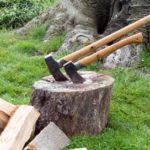Carlton Boyce gets a handle
on axes and hymns his favourite
make, Gränsfors Bruk
From Living Woods Issue 41

The invention of the axe transformed the way
primitive man practised agriculture. Wielding
an axe enabled him to create pasture from forest,
build shelters, cut firewood and defend himself from
attack. The invention of the axe speeded evolution
in unimaginable ways and it remains one of the few
tools that has passed almost unchanged from the
Stone Age to today: Oldowan man would recognise
and be able to use a modern axe with few problems.
While the earliest stone axes were held in the
palm of the hand, our ancestors realised that adding
a handle multiplied power and added leverage. The
axe head also underwent development throughout
the intervening millennia and there is now a
bewildering range of lengths, sizes, weights and
shapes of axe, all designed to do a specific job. While
you can still buy a generalist, jack-of-all-trades axe, it
is unlikely to be the master of any.
Good axes versus cheap axes
While a perfectly serviceable axe can be bought for
under £10, I’d rather buy a top-quality axe that has
been made with pride. The craftsmen at Gränsfors
Bruk stamp their initials in the axe head, for example,
so I know that Anders Strömstedt was confident
enough in my Small Forest Axe to put his name to it.
For me, a lot of the pleasure I derive from working
with and around wood comes from the way a tool
feels in my hand. A well-balanced, beautifully made
axe makes even the most tedious job – and splitting
a winter’s worth of kindling in an afternoon is a very,
very tedious job – much more pleasurable. And
because working with wood is a hobby for me, I
don’t need to keep an eye on the P&L spreadsheet.
Finally, because my three axes owe me about £250
in total (a not inconsiderable sum but far less than
a decent small chainsaw), I take a pride in looking
after them properly. Cleaning and servicing my axes
connects me not only to the men who built them,
but with others like my grandfather whose tools
always stood sharp and well-oiled.
The staff in ProAdventure in Llangollen is
knowledgeable and helpful and pointed me in the
right direction when my axe fetish first started to
develop. If you can’t get to them in person, they
also provide a very good mail order service (www.
proadventure.co.uk).
Other reputable axe manufacturers include
Wetterlings and Hultafors, as well as Fiskars for those
on a budget.

Choosing the right axe
An axe can be used to chop or split, pound or fell,
and choosing the right axe will save you time and
money in the long run. Chopping kindling is the first
job most of us buy an axe for and the ideal axe for
the job will be light and balanced in the hand, with a
concave wedge-shaped head to help it force its way
cleanly along the length of the wood.
Such an axe is commonly known as a hatchet and
can be bought from your local DIY superstore for
as little as £10 or as much as £80 for a hand-forged
Swedish axe like the Gränsfors Bruk Splitting Hatchet
I use. Whether you go for the budget option or the
professional hand-crafted one, it is important to pick
a hatchet that is well-balanced and light enough to
be used single-handed.
Splitting larger logs calls for a similarly shaped
head, but an axe or maul with more weight and a
longer handle will enable you to deliver more of a
punch — nice when you’re faced with a stubborn knot.
Don’t go for anything too heavy, though. Hitting a
log at twice the speed gives you four times the power
at impact and an axe that is too heavy to swing easily
simply won’t let you make the most of that principle.
In the same spirit, resist the urge to have a
chopping block that is set too high; mid-calf height is
ideal as it will let you hit the wood with all the force
in your swing. Incidentally, it’s also worth using a
low-power strike initially; by starting with a relatively
low-energy strike you’ll save an enormous amount
of effort because the majority of logs you encounter
will split fairly easily. Save your full-power blows for
obstinate logs, or days when you need to burn off
some frustration.
My Gränsfors Bruk Splitting Maul was another
significant investment that gives me pleasure each
time I pick it up. The handle is fit ted with a steel
collar to protect it when I inevitably miss, and the
poll (or butt, the blunt head of the axe that sits
opposite the cutting edge) is tempered to enable it
to be used as a hammer to pound a wedge in. (You
should never use any other type of axe as a hammer
as the steel is very strong but quite fragile and there
is real danger of the head shattering, sending sharp
pieces of metal flying through the air.)
Finally, a felling axe is designed to cut across the
wood fibres rather than down them like a splitting
axe. While most of us would choose a chainsaw
to fell a tree, there is real pleasure in wielding a
small axe to chop down saplings or limb trees. I use
the Gränsfors Bruk Small Forest Axe as it’s easily
transportable but heavy and versatile enough to be
used for almost anything I’d want to use an axe for in
the woods. If you’re buying your first good axe, this is
the one I’d recommend.
Care of the axe
I rub boiled linseed oil into the new handle of every
axe I buy. I start by rubbing a small quantity in with my
bare hands once a day for a week, then once a week
for a month, and then once a month for a year. I top
it up when it looks a bit dry, which normally means in
the spring and autumn.
Simply removing tree sap from the head and wiping
it over with an oily rag will go a long way to keeping
your axe in good shape. Storing it in its leather sheath
will protect your hands as well as the cutting edge.
You’ll want to touch up the cutting edge from time
to time, something a small file and a double-sided
sharpening stone make very easy. Just take your time
and follow the angle the manufacturer ground at the
factory.
If you follow these tips then your axe will not only
last you a lifetime, it will endure for generations.
Imagine seeing your grandchildren use an axe you’ve
bought and cherished for decades. Suddenly spending
£100 on an axe doesn’t sound so bad, does it?